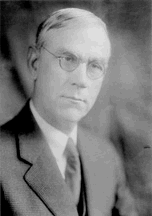Sustained as president of The Church of Jesus Christ of Latter-day Saints on October 17, 1901, Joseph F. Smith began the transition into the twentieth century. Progress was continuing for Utah and for the Church, and the Church made a huge step in missionary work when it built the Bureau of Information on the same block as the Salt Lake Temple.

Joseph Fielding Smith Mormon Prophet
The Bureau of Information served as a visitors’ center for strangers to the Mormon faith. About seventy-five people were called to serve as guides to the visitors. These guides distributed free literature about the Church to the visitors. Their friendly service and willingness to share the gospel and answer strangers’ questions did much to alleviate some of the prejudice which still weighed down on the Saints.
However, there certainly were strong memories of the issues of polygamy. In 1903, an apostle named Reed Smoot was elected to the United States Senate by the Utah legislature. Many anti-Mormons protested his being allowed a seat in the Senate because he was an apostle in the LDS Church. These people felt that because they had been successful in keeping B. H. Roberts from taking his seat in Congress, that they would easily be able to keep Smoot from taking his seat in the Senate. If they were successful in keeping Smoot from the Senate, these same people believed they could keep any endowed member of the Church from holding public office. The main claim against Roberts was his practice of polygamy, though he had been granted amnesty, but Smoot was not a polygamist. The complaint brought against him was that, since he was a leader in the Church, he believed in polygamy, and therefore should not be in politics.
Because there seemed to have been much confusion regarding the Church’s stance on this issue (despite the First Manifesto declaring polygamy would no longer be practiced by the Church), in 1904, Joseph F. Smith issued what became known as the Second Manifesto, declaring that any member of the Church who continued to enter into or solemnize a plural marriage would be excommunicated.
“Inasmuch as there are numerous reports in circulation that plural marriages have been entered into, contrary to the official declaration of President Woodruff of September 24, 1890, commonly called the manifesto, which was issued by President Woodruff, and adopted by the Church at its general conference, October 6, 1890, which forbade any marriages violative of the law of the land, I, Joseph F. Smith, President of the Church of Jesus Christ of Latter-day Saints, hereby affirm and declare that no such marriages have been solemnized with the sanction, consent, or knowledge of the Church of Jesus Christ of Latter-day Saints. And I hereby announce that all such marriages are prohibited, and if any officer or member of the Church shall assume to solemnize or enter into any such marriage, he will be deemed in transgression against the Church, and will be liable to be dealt with according to the rules and regulations thereof and excommunicated therefrom” (Conference Report, April 1904, p97).
Nineteen citizens of Salt Lake signed a formal protest asserting many false accusations against Smoot. Since they were unable to prove any of their accusations, because they were all false, this protest lost much of its momentum. However, for two years, an investigation went on, which was obviously against the Church and not Smoot. Even President Joseph F. Smith was called as a witness in the case. The Church received much press during this time, and, though much of it was negative, some was positive. Overall, the exposure benefited the Church, and Smoot was ultimately permitted to retain his seat with a vote on June 11, 1906, of 28 in favor of his expulsion, 42 against, and 20 refraining from voting. This was a turning point for members of the Church in politics and in public opinion.
At the April 1907 General Conference, the First Presidency took the opportunity to issue what became known as a Address to the World in response to many issues which had been brought up in the Smoot case and to many accusations which had been made against the Church. It was read as follows:
“If it is urged that there have been instances of the violation of the anti-polygamy laws, the plain answer is that in every state and nation there are individuals who violate law in spite of all the vigilance that can be exercised; but it does not follow that the integrity of a community or a state is destroyed, because of such individual transgressions. All we ask is that the same common-sense judgment be exercised in relation to our community that is accorded to other communities. . . . [The Church stands for the] absolute separation of Church and State; no domination of the State by the Church; no State interference with the functions of the Church, or with the free exercise of religion; the absolute freedom of the individual from the domination of ecclesiastical authority in political affairs; the equality of all churches before the law.
“The reaffirmation of this doctrine and policy, however, is predicated upon the express understanding that politics in the States where our people reside shall be conducted as in other parts of the Union; that there shall be no interference by the State with the Church, nor with the free exercise of religion. Should political parties make war upon the Church, or menace the civil, political, or religious rights of its members as such—against a policy of that kind, by any political party or set of men whatsoever, we assert the right to call upon all her children, and upon all who love justice, and desire the perpetuation of religious liberty, to come to her aid, to stand with her until the danger shall have passed. And this openly, submitting the justice of our cause to the enlightened judgment of our fellow men, should such an issue unhappily arise. We desire to live in peace and confidence with our fellow citizens of all political parties and of all religions” (Quoted in Essentials in Church History, Joseph Fielding Smith, 514–15).
Only seven years later came the beginning of World War I, and many of the members of the Church fought for their country. in 1917, the year the United States entered the war, 3,854 members of the Church served in the army, 616 in the navy, 196 in the marines, and more than 800 in other areas of the service. By 1919, there were 14,975 members of the Church serving their country.
Despite the war, the Church enjoyed a period of prosperity under President Joseph F. Smith. Missionary work was spreading all over the world, meetinghouses were built, an LDS hospital was built, and the Church’s school system expanded. Two new temples were announced: one in Cardston, Canada, and the other in Laie, Hawaii. The Saints flooded the already completed temples to do work there. The lives of the Saints and the success and growth of the Church showed the world that the Church was a good organization. Example, faith, and endurance eventually helped overcome the prejudice in the public opinion which had been building for nearly one hundred years.
Perhaps one of the most significant contributions Joseph F. Smith made during his presidency was his revelation on the redemption of the dead. In this revelation, President Smith learned of paradise, or the spirit world, or the place people go when they die where they await the day of the resurrection. President Smith learned that in the spirit world, people who died without a knowledge of the gospel are taught by the spirits of those righteous who did accept the gospel in their lifetimes. The Latter-day Saints believe that these dead can be redeemed through temple work, where essential ordinances these people died without receiving can be performed for them by proxy. After their work is done, they will then have the opportunity to choose whether they want to accept that work or reject it. This revelation broadened the Church’s understanding of temple work and of the afterlife.
In addition to all this, President Joseph F. Smith insituted the family home evening program, encouraging families to set aside time together in the home to discuss and teach the principles of the gospel. President Smith knew that as society grew more busy it was also growing less focused on the family. He knew that time spent together builds solid family ties and helps each family on its eternal path.
Twitter •


 Watch a video about the restoration of the gospel on lds.org
Watch a video about the restoration of the gospel on lds.org
I was looking for a good photo or more information on the mother of Joseph F. – Mary Fielding Smith. Would you have any information on her?
Try visiting the Church’s CES website. There are a couple of images of her there. It also has a bit more information on Mary.
http://www.ldsces.org/manuals/presidents-of-the-church-student-manual/pres-ch-04-06-6.asp
There is also a website on Joseph Fielding which has a picture of Mary:
http://josephfielding.com/1837/12/07/preston-7-december-1837/mary-fielding-smith/